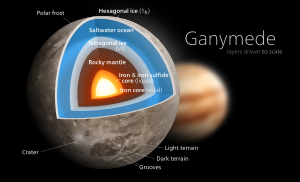Laplace-P
| Names | Europa Lander (2009–2011) |
|---|---|
| Mission type | Reconnaissance by Roscosmos |
| Mission duration | ≥ 10 years |
| Spacecraft properties | |
| Launch mass | orbiter: 4,000 kg (8,800 lb) lander: 950 kg (2,090 lb)[1] |
| Dry mass | orbiter: 2,260 kg (4,980 lb) lander: 550 kg (1,210 lb) |
| Payload mass | orbiter: 50 kg (110 lb) lander: 60 kg (130 lb) [1] |
| Start of mission | |
| Launch date | 2026 (proposed)[2] |
| Rocket | Angara-A5 with the KVTK upper stage (proposed)[3] |
| Orbital parameters | |
| PeriJovian altitude | 900,000 km (560,000 mi) |
| ApoJovian altitude | 20,000,000 km (12,000,000 mi) |
| Period | 200 days |
| Ganymede lander | |
| Landing date | 2030 (proposed) |
Laplace-P (
Initially proposed to launch with the European Jupiter Icy Moons Explorer (JUICE) in 2022, this was later changed to an independent launch on an Angara-A5 in 2023.[1][4][5] The mission was cancelled due to a lack of funding in 2017.[6]
History
The Europa Lander would have been launched in 2020s as part of the
The orbiter would perform 13 flybys of Ganymede, and 4 flybys of Callisto and carry up to 50 kg (110 lb) of scientific instruments, while the Europa lander would have carried up to 70 kg (150 lb) of scientific instruments.[10][11]
Laplace-P was cancelled in 2017 to allow more funding for the Venera-D mission.[6]
Concept

Laplace-P would be a dual mission featuring an orbiter (code name LP1) and a lander (code name LP2) to be launched together toward Jupiter. One spacecraft would orbit the moon Ganymede, while the lander would perform a soft landing on its surface.[1][12] The "P" in Laplace-P stands for "posadka" (landing).
The planned trajectory is to use the VEEGA (Venus-Earth-Earth Gravity Assist) route.[13] Both spacecraft would be carrying about 50 kg (110 lb) of scientific instruments each.[1] The lander would be powered by an RTG, while the orbiter would be equipped either with an RTG or with solar panels.[1] If the lander is launched together with JUICE, then the Russian orbiter would be omitted due to JUICE filling its role. The advanced Russian project Laplace-P orbiter's objectives is to map the surface for lander. The main objective of the lander is to carry out remote and in-situ investigations of Ganymede's surface.[14]
The radiation conditions on the Ganymede surface are fairly benign. On the other hand, the Ganymedean gravitational parameter (GM = 9887.8 km3/s2) makes the landing on it from the orbit more difficult than in the case of Europa.[13]
Objectives
The main objectives of the mission would have been to study Ganymede's atmosphere, icy surface, habitability, and perform an in-situ search for biosignatures.[3]
See also
- Moons of Jupiter
- Europa Lander (NASA)
- Jupiter Icy Moons Explorer (JUICE)
References
- ^ a b c d e f g h "Russia funds a proposal to land on Jupiter's moon Ganymede". Russianspaceweb. Archived from the original on July 30, 2015. Retrieved August 11, 2016.
- TASS. 5 July 2016. Retrieved 2017-01-08.
- ^
- SPACE.com. Retrieved August 25, 2015.
- ^ a b L. Zelenyi; et al. (2009). Europa Lander: Mission Concept and Science Goals (PDF). European Planetary Science Congress. Vol. 4. EPSC2009-615-1. Archived (PDF) from the original on 2021-07-20.
- ^ a b Струговец, Дмитрий (15 July 2017). "Вице-президент РАН: сроки реализации лунной программы сдвинулись ради проекта «ЭкзоМарс»". TASS. Archived from the original on 5 July 2018.
- ^ K.P. Hand (February 9–13, 2009). "Report on the Europa Lander Workshop" (PDF).
- ^ Staff (March 12, 2015). "NASA's Hubble Observations Suggest Underground Ocean on Jupiter's Largest Moon". NASA News. Retrieved 2015-03-15.
- ^ Clavin, Whitney (1 May 2014). "Ganymede May Harbor 'Club Sandwich' of Oceans and Ice". NASA. Jet Propulsion Laboratory. Retrieved 2014-05-01.
- ^ International Workshop "Europa lander: science goals and experiments". 9–13 February 2009.
- ^ International Workshop “Europa lander: science goals and experiments” Archived 2021-07-19 at the Wayback Machine (9–13 February 2009) [announcement]
- S2CID 255277449.
- ^ a b Grushevskii, A. V.; Golubev, Yu.F.; Koryanov, V.V.; Tuchin, A. G. To the Adaptive Multibody Gravity Assist Tours Design in Jovian System for the Ganymede Landing (PDF) (Report). Archived (PDF) from the original on 2022-04-19. Retrieved 2016-03-09.
- S2CID 255067651. Retrieved 26 Feb 2018.



